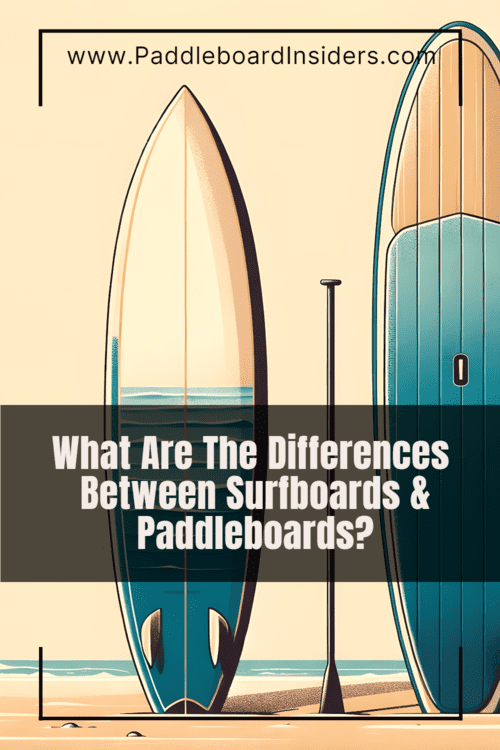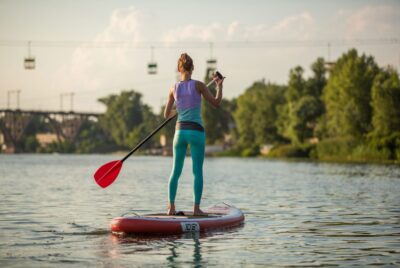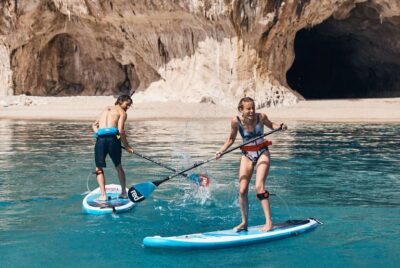Paddle Board Vs Surfboard: What Are The Key Differences?
*We may earn a commission for purchases made using our links. Please see our disclosure to learn more.
The decision of paddle board vs surfboard can be a tough choice. Paddle boarding is one of the fastest-growing water sports in recent years, but surfing is really cool!
This article will dive into the key differences to help you choose the right board for your water adventures.
Get ready to catch some waves! 🌊🏄♂️
| Looking for our best paddle board product recommendations? Check the Paddleboard Insiders Buyer Guides |
Table Of Contents
- The Key Differences Between A Paddle Board vs Surfboard
- Which Board is Right for You?
- Pros and Cons of Paddle Boards and Surfboards
- My Best Paddle Board Recommendations:
- Conclusion
- Paddle Board vs Surfboard: FAQs
- What is the main difference between a paddle board vs surfboard?
- Can I use a paddle board to surf waves?
- Do I need special skills to use a paddle board or a surfboard?
- Which type of board offers better stability – paddle board or surfboard?
- Can I use the same equipment for both paddle boarding and surfing?
The Key Differences Between A Paddle Board vs Surfboard
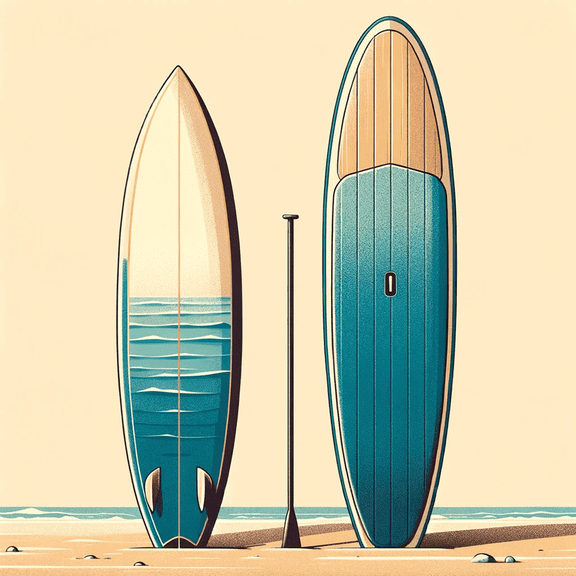
There are a few really key differences between a paddle board vs surfboard that will give you a good idea of their intended uses:
Design & Size
| Paddle Boards | Surfboards |
| Typically larger and wider than surfboards. They offer more stability and are designed for standing up with a straight posture. Paddle boards often have a flat, wide surface and are thicker to provide buoyancy. | Generally smaller, thinner, and more streamlined than paddle boards. They are designed for maneuverability and speed on waves. Surfboards have a pointed nose and a tapered tail, which helps in cutting through waves. |
Purpose & Use
| Paddle Boards | Surfboards |
| Mainly used for paddleboarding, where the rider stands upright and uses a paddle to move through the water. This activity can be recreational, for fitness, or even for racing. Paddle boards are suitable for calm waters like lakes and slow-moving rivers. | Designed specifically for surfing – riding the waves in the sea. Surfboards are meant to be stood upon only when a wave is ridden, and the rider typically lies down and paddles with their hands to catch waves. |
Construction Materials
| Paddle Boards | Surfboards |
| Paddle boards often require more buoyant materials to support the weight of a standing person. They are either inflatable or solid. Solid paddle boards are generally similar to surfboards in construction but just bigger. | Made from fiberglass, epoxy and foam. They are usually much smaller so that a surfer can ride the face of a wave. |
Skills & Techniques
| Paddle Boards | Surfboards |
| Involves skills such as balancing while standing, paddling techniques, and navigating through various water conditions. | Requires skills like wave selection, paddling into waves, popping up to stand on the board, and maneuvering on the waves. |
Types & Variations
| Paddle Boards | Surfboards |
| There are different types of paddle boards, such as flatwater boards, racing boards, and inflatable boards, each designed for specific conditions and uses. | Come in a range of shapes and sizes, like longboards, shortboards, fish boards, and gun boards, each tailored to different surfing styles and wave conditions. |
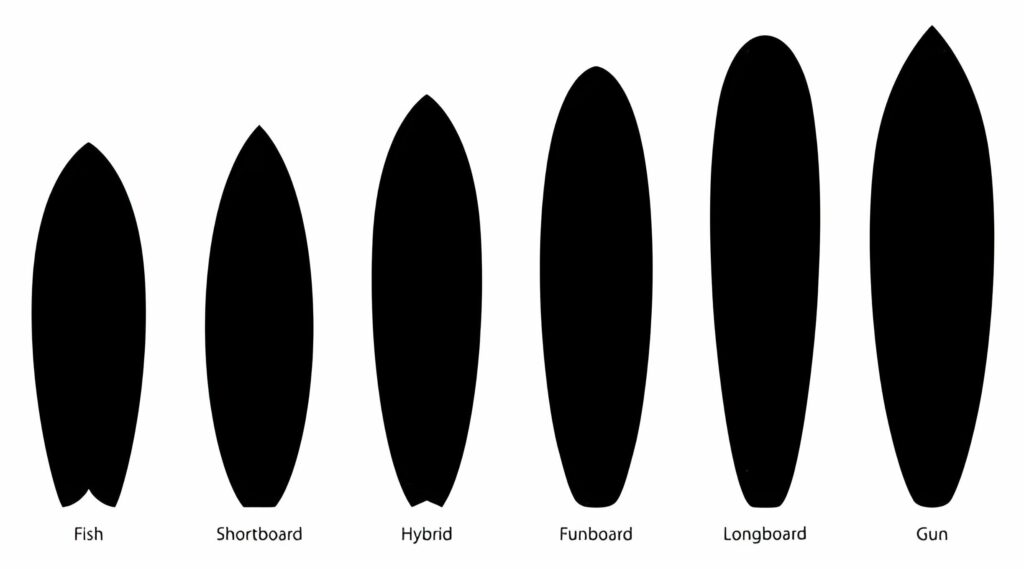
Surfboards come in a large range of types and sizes (just like paddle boards)
Which Board is Right for You?
Consider your skill level and intended use when choosing between a paddle board and surfboard. Evaluate your local water conditions to determine which board would be the best fit for your needs.
Consider your skill level
Evaluate your skill level honestly. If you’re a beginner, paddle boarding provides a more stable platform for learning the techniques and skills needed to balance on the water. On the other hand, if you have experience in surfing or watersports, a surfboard might be the right fit for you to challenge yourself with its maneuverability and speed.
Each board requires different levels of skill and practice to master. Assess your current abilities before making a decision about a paddle board vs surfboard.
| Want to see how easy it is to stand on a SUP? Check this out… How To Stand On A Paddleboard: The Definitive Guide |
Think about your intended use

Consider your intended use when choosing between a paddle board and a surfboard. If you prefer calm waters, yoga, or long-distance paddling, a paddle board can offer stability and versatility for various activities.
On the other hand, if you’re seeking thrills on ocean waves or are passionate about surfing techniques, a traditional surfboard may be more suitable for your needs.
Whether it’s cruising along tranquil coastlines or riding challenging waves at the beach, understanding your intended use will help you select the right board that aligns with your water sports aspirations.
Evaluate your local water conditions
Before choosing between a paddle board and a surfboard, it’s essential to evaluate your local water conditions. Factors such as wave size, currents, and the presence of obstacles can significantly impact your boarding experience.
Assessing whether you’ll be paddling in calm lakes, rivers with variable currents, or ocean waves will help determine which board is best suited for your local environment.
Understanding the characteristics of the water where you plan to board is crucial for safety and enjoyment. For instance, calm waters may favor a stable stand-up paddleboard (SUP), whereas more turbulent conditions might call for the maneuverability of a surfboard.
| Looking for examples of the best paddle boards in 2024? The 8 Best Inflatable Paddle Boards Of 2024 Reviewed |
Pros and Cons of Paddle Boards and Surfboards
Paddle Boards: Versatility and Ease of Use. Surfboards: Speed and Maneuverability. Find out which board is right for you! Read on to explore the key differences between paddle boards and surfboards.
Paddle Boards: Versatility and Ease of Use
Paddle boards offer versatility and ease of use, making them suitable for various water activities. Their stable platform allows for easy maneuvering, making them ideal for beginners learning the techniques of balance and paddling.
The inflatable paddle board options further enhance their convenience, as they are portable and easily transportable to different water locations.
Stand-up paddle boarding provides a versatile experience suitable for both calm waters and small waves. This makes it an attractive option for those who enjoy spending time on the ocean or at the beach.
Surfboards: Speed and Maneuverability
Surfboards offer remarkable speed and excellent maneuverability, enabling riders to glide swiftly across the waves and perform dynamic turns with agility. Their sleek, streamlined design allows for exceptional acceleration when catching waves.
The narrow nose and tapered tail facilitate quick directional changes, providing surfers with responsive control over their movements in the water.

Riders can swiftly navigate through the ocean’s dynamic environment, harnessing the board’s speed to execute precise manoeuvres on varying wave conditions while enjoying an exhilarating surfing experience.
My Best Paddle Board Recommendations:
I don’t have much knowledge about surfboards, but I can tell you the best paddle boards for you to look into if that’s the direction you want to take.
Here are my 3 favorite SUPs for beginners:
Recommendation 1: Tower Adventurer 2 (Best Everyday Board)
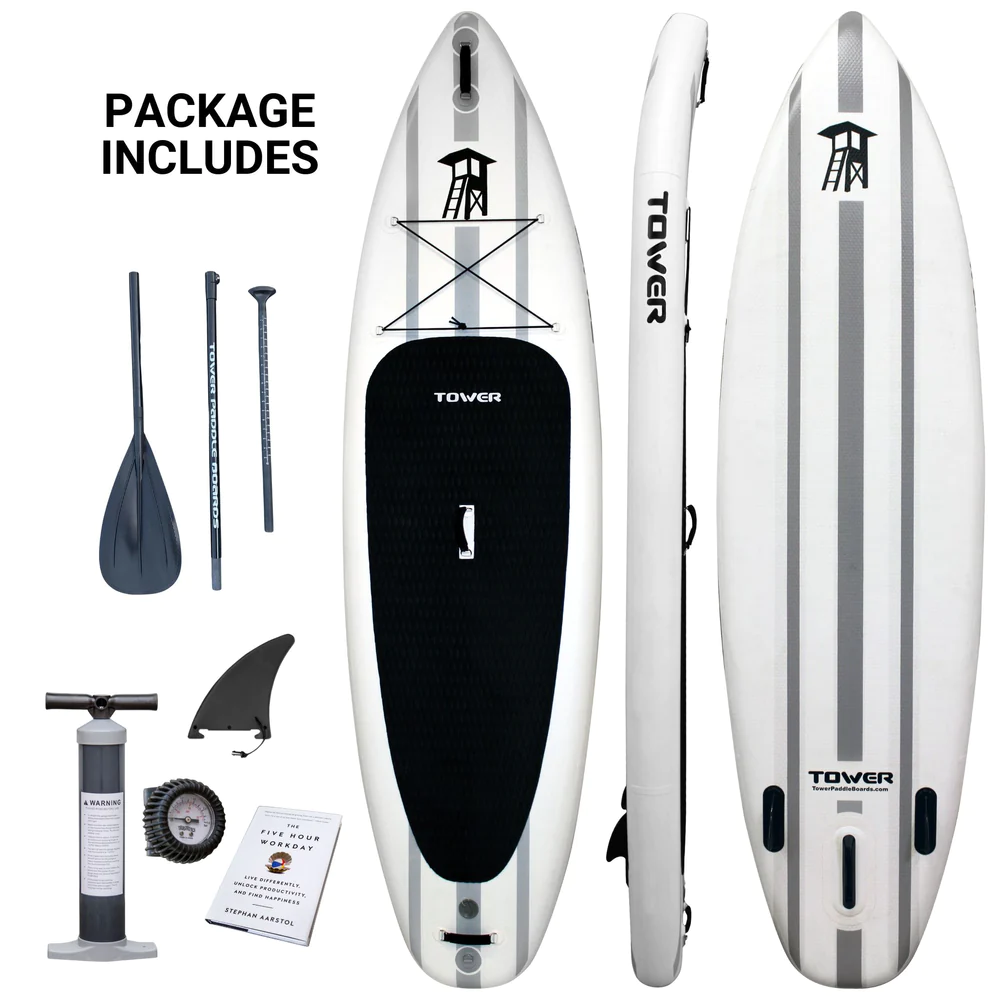
Where To Buy: Tower Paddleboards
Specs & Features:
– Dimensions of 10’4″ x 32″ x 6′
– Weight capacity of 350 lbs
– Comes with paddle, board, pump, fin and book
The Tower Adventurer 2 inflatable paddle board is a great pick for beginner paddle boarders. This SUP is well renowned for its stability and support, which helps new paddlers gain confidence on the water. It’s easy to get back on to if you fall off in the water which makes it amazing to learn. As part of the reputable Tower brand, known for quality in the paddle board market, this board assures reliability. It is easy to stand on, extremely durable and is the perfect choice for most people.
It’s perfect for recreational paddling, blending stability with agility. Ideal for family outings or those new to paddleboarding, the Tower Adventurer 2 is a top pick for anyone seeking a dependable and enjoyable paddleboarding experience. I highly recommend this SUP and I definitely think you should consider it if you’re in the market for a paddle board.
| Check Price ➡️ Tower Paddleboards |
Recommendation 2: Atoll 11′ iSUP (Best For Heavier Riders)
Where To Buy: Amazon
Specs & Features:
– Dimensions of 11′ x 32″ x 25″
– Weight capacity of 400 lbs
– Comes with board, bag, leash, fin and paddle
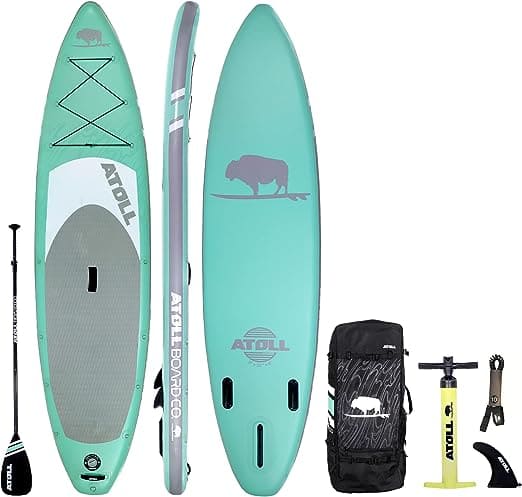
The Atoll Inflatable Stand Up Paddle Board (ISUP), enhanced for 2024, is a perfect option for heavier paddlers. Featuring a cutting-edge ultra-light, dual-layer PVC build, it’s 40% lighter than comparable boards yet remains extremely durable. This 11-foot board comes with a Bravo high-pressure, dual-action hand pump for easy inflation.
The package includes a 3rd generation black aluminum alloy paddle, lightweight and efficient, along with a detachable fin that fits most fin boxes without needing tools or worrying about lost screws. For convenient transport and storage, there’s a robust backpack with mesh sides, allowing the board to dry when packed away.
Measuring 25 inches in thickness, 32 inches in width, and 11 feet in length, this board is versatile for various activities. It’s reinforced with an additional PVC layer for increased stiffness, and boasts 15 D-rings for added functionality. The fixed Tri-fin design enhances stability and tracking. Additionally, it comes with a 2-year warranty from the manufacturer, making it an excellent choice for those new to paddleboarding or looking to upgrade their equipment.
| Check Price ➡️ Amazon |
Recommendation 3: ISLE Switch 11’6″ Hybrid (Best Hybrid Board)

Where To Buy: Amazon
Specs & Features:
– Dimensions of 11.6 x 35.5 x 6
– Weight capacity of 425 lbs
– Comes with leash, pump, backpack, board, attachable kayak seat and paddle.
The ISLE Switch stands out as a unique inflatable hybrid, serving both as a kayak and a stand-up paddleboard (SUP). It’s designed to accommodate riders up to 425 lbs, seamlessly transitioning from SUP to kayak, making it perfect for both solo and tandem use. The board’s adaptability is further enhanced by the ISLE-LINK connect system, which simplifies changing configurations and even allows for linking two boards together.
Built with Air-Tech Fusion Lite technology, the Switch is impressively 25% lighter than typical inflatables, weighing in at only 19 lbs, yet it maintains a high level of durability. Its extensive traction pad provides utmost comfort for a variety of activities, ranging from yoga to relaxing with pets or children. In kayak mode, it offers a high-back elevated seat and an ergonomic footrest for added comfort and support.
With dimensions of 11.6 x 35.5 x 6 inches and a capacity of 425 lbs, the Switch is an excellent option for those looking for a versatile, lightweight watercraft. It includes all necessary accessories — a kayak seat, an adjustable SUP paddle, a hand pump, a travel bag, and a center fin — making it a comprehensive solution for SUP adventures.
| Check Price ➡️ Amazon |
Conclusion
In conclusion, choosing between a paddle board and a surfboard depends on various factors. Assessing your skill level, intended use, and local water conditions are crucial in making the right decision.
Both boards offer unique advantages, with paddle boards being versatile and easy to use, while surfboards excel in speed and maneuverability. Understanding these key differences will help you make an informed choice that suits your individual preferences and needs.
| Looking for insider guides to some amazing paddle boarding locations? Check the Paddleboard Insiders Location Guides |
Paddle Board vs Surfboard: FAQs
What is the main difference between a paddle board vs surfboard?
Paddle boards are designed for standing paddling on calm waters, while surfboards are used for riding waves in the ocean.
Can I use a paddle board to surf waves?
While it’s possible to catch small waves on a paddle board, they are not specifically designed for surfing and may not perform as well as traditional surfboards.
Do I need special skills to use a paddle board or a surfboard?
Both paddle boarding and surfing require some level of skill, but beginners can start with basic techniques under proper guidance before advancing to more challenging conditions.
Which type of board offers better stability – paddle board or surfboard?
Paddle boards generally offer better stability due to their wider and thicker design compared to the sleeker, narrower shape of most surfboards.
Can I use the same equipment for both paddle boarding and surfing?
Paddle boarding typically requires a specific type of board known as a stand-up paddle (SUP) board, while surfing necessitates the use of specialized shorter boards called surfboards; therefore, the equipment is not interchangeable between these activities.
